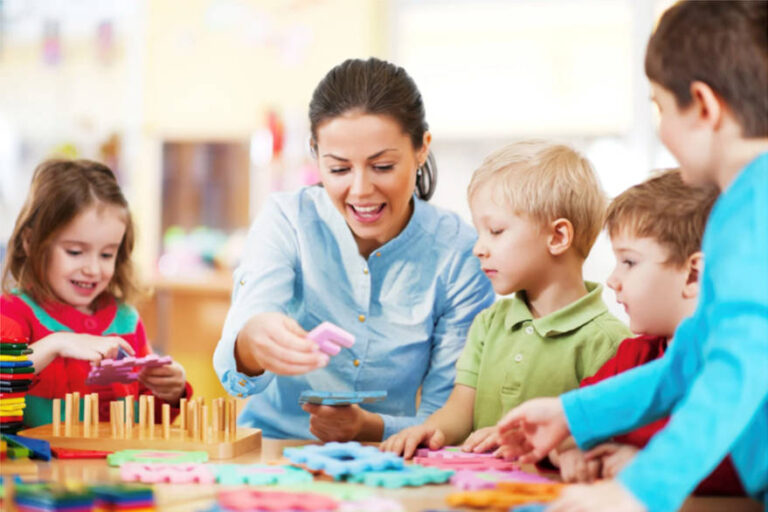In March we started a conversation with Ofsted around their current inspection consultation phase, and found ourselves on the subject of uncertainty within the early years community. With a mind to have your voices heard, Ofsted agreed that we could gather your questions and send them their way.
And here we are. You asked, they answered, and now we have 11 Ofsted questions and answers straight from the source.
Want to ask more questions? You can do so right here and we’ll send them to Ofsted when we have another batch, or you can still take part in their consultation phase related to their inspection proposals.
The power is in your hands – make your voices heard!
A word from Ofsted
“We are grateful to the users and followers of Blossom, such as yourself, that have taken the time to ask these questions, share their views either through the Big Listen, the current consultation or through direct contact with us. We know we cannot serve children well without the trust and confidence of the people we inspect, so your views really matter to us.
“In February we launched our consultation seeking the views of parents, carers, professionals and learners, on a new approach to inspecting and reporting on education providers, including early years providers. The consultation runs until 28 April.
“If you have not already done so, please take the time to read through our proposals and share your views: Improving the way Ofsted inspects education - GOV.UK.”
Ofsted, March 2025
11 Ofsted Questions and Answers
For full transparency, all responses to the questions below are word-for-word from Ofsted. Some questions have been edited for length, and any emphasis in the answers is our own.
1. For all preschools (term time only), why doesn't Ofsted adopt the same approach as schools and not inspect within the first week due to settling in?
Unlike our role with schools where we are just the inspectorate, we are both the regulator and the inspectorate for early years. As a result, we carry out inspections of all providers on the Ofsted Early Years Register according to our early years inspection handbook.
Our Best Start in Life (BSIL) research acknowledges that the early education system comprises of a range of different providers, and provision has been developed and funded variably. To be fair and consistent, we use the same inspection methodology for all early years (EY) providers.
In our proposed new toolkits, we give greater emphasis to understanding providers’ context on inspection. Inspectors will use this information to help understand the circumstances in which leaders are operating and to evaluate their work in context – for instance, whether they are working hard in a disadvantaged area facing particular challenges.
This may include new intakes of children. We want to make sure our inspections are nuanced to different provider types. But, if you do have a view of this proposal, please do go to our consultation to make sure it is included.
2. Why is PLAY not an important factor [in inspections?], as per Ofsted statement issued

Part 3 of our Best Start in Life (BSIL) research explains the importance of play for children’s learning. The overall conclusions state that practitioners should make it as easy as possible for children to learn:
‘Play-based learning and direct instruction are both important for young children. Sometimes, play-based learning is the best approach. Other times, children need an adult to show or teach them something new. Research suggests that the most effective settings combine both approaches.’
Ofsted, Best Start in Life
We don’t have specific guidance about our expectations relating to play. The Department for Education in the Early Years Foundation Stage (EYFS) provides the curriculum framework that early years leaders use to decide what they intend children to learn.
Leaders and practitioners decide how to implement the curriculum so that children make progress in these areas of learning. During inspection inspectors observe children at play. This helps them to evaluate the impact of the curriculum at the setting.
3. How will Ofsted ensure consistency throughout their inspectors?

From our Big Listen we heard criticisms that some believe our inspections are carried out inconsistently. We also heard that our inspectors do not always have the expertise or experience in the specific types of providers they inspect, or do not quite understand the context the provider is working in.
In our response to the big listen we show how changes to inspector recruitment and training will help. For example, last autumn, we launched the Ofsted Academy. This is investing in our highly skilled inspector and non-inspector staff by drawing together induction, training, learning, professional development and good practice in one place.
As part of our proposed changes to inspection, we aim to balance context with consistency. We know we can and must do more to maintain consistency, but we need to be consistent in a way that also understands provider’s individuality.
It does not mean an identical approach to every type of provider but instead, tailors our approach both to the type of provision and also the circumstances in which it is offered.
4. How will Ofsted be monitoring what good CPD looks like? How do they intend on inspecting the CPD provision without budget being a mitigating factor?

Our Best Start in Life research highlights that, while CPD is important for high-quality EY provision, it is likely to be dependent on the approach taken by individual providers or local areas. This is part of the context inspectors consider on inspection.
Beyond the requirements of the EYFS, we don’t specify the types of training settings use or how settings should deliver their training. Instead, inspectors will consider what impact any continued professional development has on staff and the children in the context of the setting.
5. How can nurseries show evidence over time with child development when the children move on so quickly?
For settings to meet the exemplary standards proposed in our consultation, their strong practice must be embedded and sustained over time. We acknowledge that settings need to continue to meet children’s individual needs based on their starting points and what they need to learn next.
For example, there may be evidence that the curriculum has been significantly supporting the knowledge, confidence and expertise of staff in teaching all the areas of learning over time. But we are undertaking visits at the moment to test the EY toolkit and we want to hear your views via the consultation.
6. Are there any plans to support nurseries with the early intervention resources or capacity needed to support developmental concerns early?
Our Best Start in Life research review highlights the importance of high-quality early education for children who have or may have SEND. The purpose of the research is to support practitioners to raise the quality of early years education.
This includes designing an ambitious curriculum for all children. Inspectors are tasked with finding out what it is like for a child at the setting. They will want to know how well practitioners understand children’s starting points and what they need to learn next.
In our renewed inspection framework, the proposed toolkit has a focus on inclusion through a dedicated evaluation area and this is threaded throughout the toolkit. Inspectors will consider the context of the early years setting during the inspection through their professional dialogue and shared observations with leaders.
There are significant proposals in our consultation about how we inspect SEND and inclusion so please do share your views with us.
7. How will Ofsted inspect efforts for early intervention in private nurseries that don’t have additional funding for SEND children, additional training and low wages for staff?
In our proposed toolkit (designed to show inspectors and you the evaluation areas that we’ll focus inspections on and how we’ll assess and grade providers) we are considering the setting’s context in more detail.
This includes the number of children on roll with SEND and those that the provider has identified as requiring additional support. Inspectors will take account of this context when evaluating the quality of the provision.
The toolkit explains how inspectors will look at inclusion and provision for children with SEND during inspection. Leaders can use this when reflecting and evaluating their provision. Inspectors are tasked with finding out what it is like for a child at the setting.
This will include shared observations and professional discussion with leaders and staff. Remembering, as His Majesty’s Chief Inspector, Sir Martyn Oliver, says, if settings are getting it right for children with SEND, then it is likely they are getting it right for all children.
But we want to hear your views on the toolkits, so if you have any comments about them – things you like or things you think should change, please let us know via our consultation.
8. What will change on the day of inspection [following recent announcements]?

As we are currently in a consultation period, it is important to remember nothing is decided.
We are proposing a two-part notification call which will gather information about the setting’s context, curriculum, strengths and areas for development. We will be introducing an evaluation area on inclusion as part of the toolkit, sharpening our focus on children with SEND and those who are disadvantaged or vulnerable.
We are also testing a more collaborative approach with leaders/managers where we can have shared observations and professional dialogue with the leader/manager throughout the inspection. We are proposing that inspectors take reflection times and opportunities for evaluative discussion with leaders. There are no proposed changes to the current length of the inspection day.
What are your thoughts on these proposed changes? Let us know via our consultation.
9. What do Ofsted see for the future of inspections looking like, getting the balance between gathering an accurate picture of the setting, the children's needs, being mindful of manager workload, and how to evidence it?
We will always make sure inspectors work within the context of the setting. Inspectors will work closely with leaders/managers throughout the inspection with empathy, professionalism, courtesy and respect.
While it might look like there is more to consider on inspection because there are 8 evaluation areas, rather than 4 judgements, we are not proposing to look at anything more than we do currently. What we’ve done is to break down what we look at into smaller chunks so that we can be more nuanced about where aspects of a provision are stronger and where attention might be needed.
We’re really hoping that this means that we have better reporting on where there are strengths and, where improvements need to be made, we can be clearer so that this supports settings to focus their efforts on where they are needed most.
10. As the majority of nursery's are privately owned, what are the alterations nursery managers can expect [to inspections and report cards] to achieve exemplary as they're less likely to support local providers?
As we are currently in consultation it is important to reflect views like this one by responding to the consultation.
Under our proposals, any elements of practice considered as exemplary would be moderated and confirmed by the proposed national consistency panel. Once the grades are confirmed and the setting’s report card is published, inspectors will ask leaders to submit a short case study of their work to the Ofsted Academy.
After further national review, successful submissions will be published as part of a series of best practice reporting. This will allow the early years sector to celebrate and reflect on exemplary practice nationally. This in turn will support other settings.
11. I'd like to see how nurseries will be monitored differently than schools, as schools are maintained and DfE funded while nurseries are often privately funded.
At Ofsted we acknowledge that the early years landscape is large and varied. There is not a level playing field.
Our Best Start in Life research review, part 1 further considers the complexities of the early years workforce. It is the Department for Education that sets the requirements for all early years providers, within the statutory framework – the EYFS.
We have based the secure standards in the toolkit on the principles and the requirements of the EYFS. We will give clear explanations of how we will use the toolkit for different provider types within the early years operating guide.
But, as always, if you have a view then please do let us know via our consultation. This really is your chance to feed back on our proposals.
What's next?
Ofsted’s consultation is still ongoing (as the links in the above answers have suggested), and it’s clear they’re still looking for responses. If you haven’t already, take a look at their proposals and place your views on the consultation.
If you have more direct questions for Ofsted, you can submit them through this form. We won’t send them through one at a time, but once we’ve got 10 or more we’ll fire them over and get Ofsted’s responses up on the blog.
Want to be the first to know when we’ve got more great EYFS, Ofsted and Early Years content? Sign up to our blog!